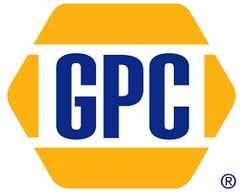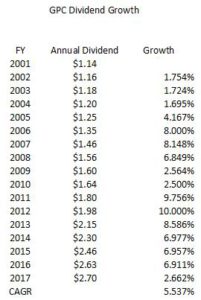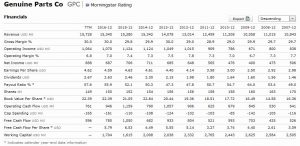Contents
 Summary
Summary
- GPC released Q3 results below expectations on October 19 which has resulted in a ~8.5% drop in stock price.
- Two additional bolt-on acquisitions were announced October 19 with closings to occur November 1. No definitive closing date has been revealed regarding the acquisition of Europe's Alliance Automotive Group.
- GPC, established 1928, has previously successfully navigated challenging competitive conditions. Management is taking steps to expedite corrective action.
- Industry dynamics presents an opportunity in that GPC is likely to be a consolidator of smaller competitors.
- Amazon’s expansion into GPC’s automotive parts segment will appeal to the DIY/consumer market (25% of GPC’s business in that segment). Amazon is unlikely to be able to adequately service the commercial segment.
Introduction
Genuine Parts Company (NYSE: GPC) is currently operating in a challenging environment. Competition is fierce and the ability to increase margins is elusive. In GPC’s Q3 Earnings Release, Paul Donahue (President and CEO) remarked:
“Our third quarter profitability was impacted by lower gross margin and higher operating expenses, as our initiatives to drive margin expansion did not meet our expectations. To that point, our plans and initiatives are underway to expedite corrective action."
A Business Overview can be found in this July 24, 2017 post. In that post, GPC was recommended as a BUY at ~$82.70. GPC’s stock price subsequently appreciated ~18.5% (~$98) as at the market close on October 18. Subsequent to the October 19th release of less than stellar Q3 results, GPC’s stock price retraced to ~$89.70 (~8.50%). This still represents a ~8.5% increase in price relative to the July 24, 2017 value.
This post reviews:
- the Amazon threat
- growth prospects
- Q3 results and guidance for the remainder of FY2017
- the safety of GPC’s dividend
- GPC’s valuation
and is followed by a recommendation.
Amazon Threat Real But Overblown
Amazon’s expansion into the aftermarkets parts business will impact GPC’s various divisions but not to the same extent as its competitors (AutoZone (NYSE: AZO) and Advanced Auto Parts (NYSE: AAP)). The DIY market will continue to shift purchases to Amazon since most users in this market already use the internet to search for parts. Commercial customers, however, will be more hesitant to drop reliable suppliers such as GPC in favor of Amazon.
GPC’s automotive segment accounts for more than half of total sales of which ~75% are commercial sales and ~25% are DIY/consumer. The DIY/Consumer segment of GPC’s competitors is a much larger portion of the mix. As a result, Amazon should impact their businesses to a greater extent than GPC.
The heavier concentration on commercial sales will shield GPC to some extent from Amazon in that commercial parts sales deliveries typically require a very short delivery timeframe. DIY/consumer parts are less time sensitive. Unless Amazon makes a strategic acquisition to compete directly with automotive parts suppliers (ie. GPC) heavily focused on the commercial segment it is unlikely that GPC will become another Amazon casualty in the foreseeable future.
An interesting review on Amazon’s potential to disrupt GPC’s space can be found in this Automotive News article.
Growth by Acquisition
Although GPC is experiencing challenges in the markets in which it competes, it has the ability to be an industry consolidator.
GPC is expanding the automotive parts segment of its business to Europe via the impending acquisition of Alliance Automotive Group.
On October 19th, GPC announced two additional bolt-on acquisitions. Both have an effective close date of November 1, 2017.
Growth by acquisition comes with its risks. Despite extensive due diligence it is possible the business being acquired may not be what was expected, culture can be different, a portion of the customer base being acquired may not remain subsequent to the acquisition, systems integration may pose a challenge, etc.. GPC, however, has made multiple acquisitions since its founding in 1928. Its proven ability to properly integrate acquired entities into the GPC fold should give investors comfort that the impending acquisitions will add long-term shareholder value.
Q3 2017 results
On October 19, 2017 GPC released its Q3 2017 results for the 3 and 9 months ended September 30, 2017.
Q3 sales relative to Q3 2016 results increased 3.6% for the Automotive Group (~53% of FY2016 total revenue), 7.1% for the Industrial Group (~30%), and 11.6% for the Electronics Materials Group (4%). Sales in the Office Products Group (13%) were down ~4.7%. Results were not as positive when viewed on a comparable basis (refer Q3 earnings announcement).
Readers should take into consideration that Q3 results were negatively impacted by disruption from unprecedented natural disasters (hurricanes and earthquakes) and one less billing day in the quarter.
Gross margin shrank marginally despite initiatives undertaken to expand margins. Management has indicated plans and initiatives are underway to expedite corrective action.
Higher operating expenses were also incurred even before taking into consideration expenses related to the impending acquisition of Europe's Alliance Automotive Group which was announced September 25, 2017.
Guidance for Remainder of FY2017
Sales guidance has been revised upwards from 3% - 4% to 4% - 4.5%. Diluted EPS and adjusted diluted EPS have been revised from $4.47 - $4.52 and $4.55 - $4.60 respectively compared to the prior outlook of $4.70 - $4.75. Adjusted diluted EPS excludes any Q4 2017 revenue, earnings or expenses, including transaction costs, associated with the pending acquisition of Alliance Automotive Group.
Dividend
The recent pullback in GPC’s stock price following the Q3 earnings release has restored GPC’s dividend yield to above 3%; GPC’s dividend distribution history can be found here.
GPC has increased its dividend for 61 consecutive years putting it in the exclusive Dividend King list of companies; a Dividend King is a company which has increased its dividend for at least 50 consecutive years.
The reason GPC is a member of this exclusive group of companies is that:
- Management has proven it can use acquisitions of smaller rivals to keep sales, earnings, and free cash flow relatively stable/growing even in times of economic uncertainty despite the cyclical nature of its businesses.
- Demand for aftermarket replacement parts/services is fairly recession-resistant. A quick comparison between GPC’s stock price reaction and that of the S&P500 during the Financial Crisis shows that GPC’s tock price outperformed the S&P 500.
- GPC has a conservative approach to dividend growth as demonstrated below.
 Source: GPC website
Source: GPC website
Coupled with a conservative dividends/EPS payout ratio and dividends/ Free Cash Flow payout ratio, investors have some reassurance that GPC has a sufficient cushion to protect its dividend regardless of economic conditions.
 Source: Morningstar
Source: Morningstar
Valuation
Prior to the Q3 earnings announcement, GPC’s stock price had appreciated to ~$98 on October 18, 2017. Using the mid-point ($4.725) of the prior adjusted diluted EPS outlook of $4.70 - $4.75, this resulted in a 20.75 price/adjusted diluted EPS.
The significant downward revision in earnings estimates has had a sudden impact on GPC’s stock price. A ~$8.30 (~8.5%) drop now places GPC’s stock price at ~$89.7. This stock price and an adjusted diluted EPS of $4.575 result in a ~19.6 price/adjusted diluted EPS.
Subsequent to the mid August 2017 low stock price (~$81), GPC’s stock price exhibited a gradual increase. The stock price surged just prior to, and subsequent to, the September 25, 2017 Alliance Automotive Group acquisition announcement.
A 21% price increase from the August 2017 low to $98 was likely fueled by investors jumping on the GPC bandwagon and/or algorithmic trading. This type of price reaction is typically not conducive to the creation of long-term wealth but rather benefits short-term traders.
Even though GPC’s stock price has been negatively impacted because of a less than stellar earnings announcement, the weakness in GPC’s stock price should be viewed as a buying opportunity by long-term investors.
Final Thoughts
Readers focused predominantly on short-term results will not be pleased with GPC’s Q3 results. Investors with a long-term investment time horizon, however, should take the recent pullback in stride.
GPC has been in operation since 1928 and has weathered several challenging business conditions. While the current challenges are slightly different from those previously experienced, GPC is one of the leaders within its space. GPC should continue to benefit from market consolidation as it is most likely to be a “survivor” as opposed to a “casualty”.
Management is strong and the company’s financial position gives it the ability to make strategic accretive acquisitions/expand its network. It also has the resources to make the necessary investments to improve efficiency thus raising the barrier to entry for new entrants or making it increasingly difficult for smaller/less well capitalized competitors.
Amazon does pose a threat to some extent but it will take considerable heavy lifting on its part to establish a strong permanent foothold in the space where customers desire speed of delivery and knowledge/expertise from vendors.
The ~18.5% appreciation in stock price subsequent to the July 24, 2017 BUY recommendation and purchase for the FFJ Portfolio was unwarranted. Readers considering a long-term investment in GPC should welcome the pullback in the stock price following the release of the Q3 results.
Note: I sincerely appreciate the time you took to read this post. As always, please leave any feedback and questions you may have in the “Contact Me Here” section to the right.
Disclaimer: I have no knowledge of your individual circumstances and am not providing individualized advice or recommendations. I encourage you not to make any investment decision without conducting your own research and due diligence. You should also consult your financial advisor about your specific situation.
Disclosure: I am long GPC.
I wrote this article myself and it expresses my own opinions. I am not receiving compensation for it and have no business relationship with any company whose stock is mentioned in this article.


